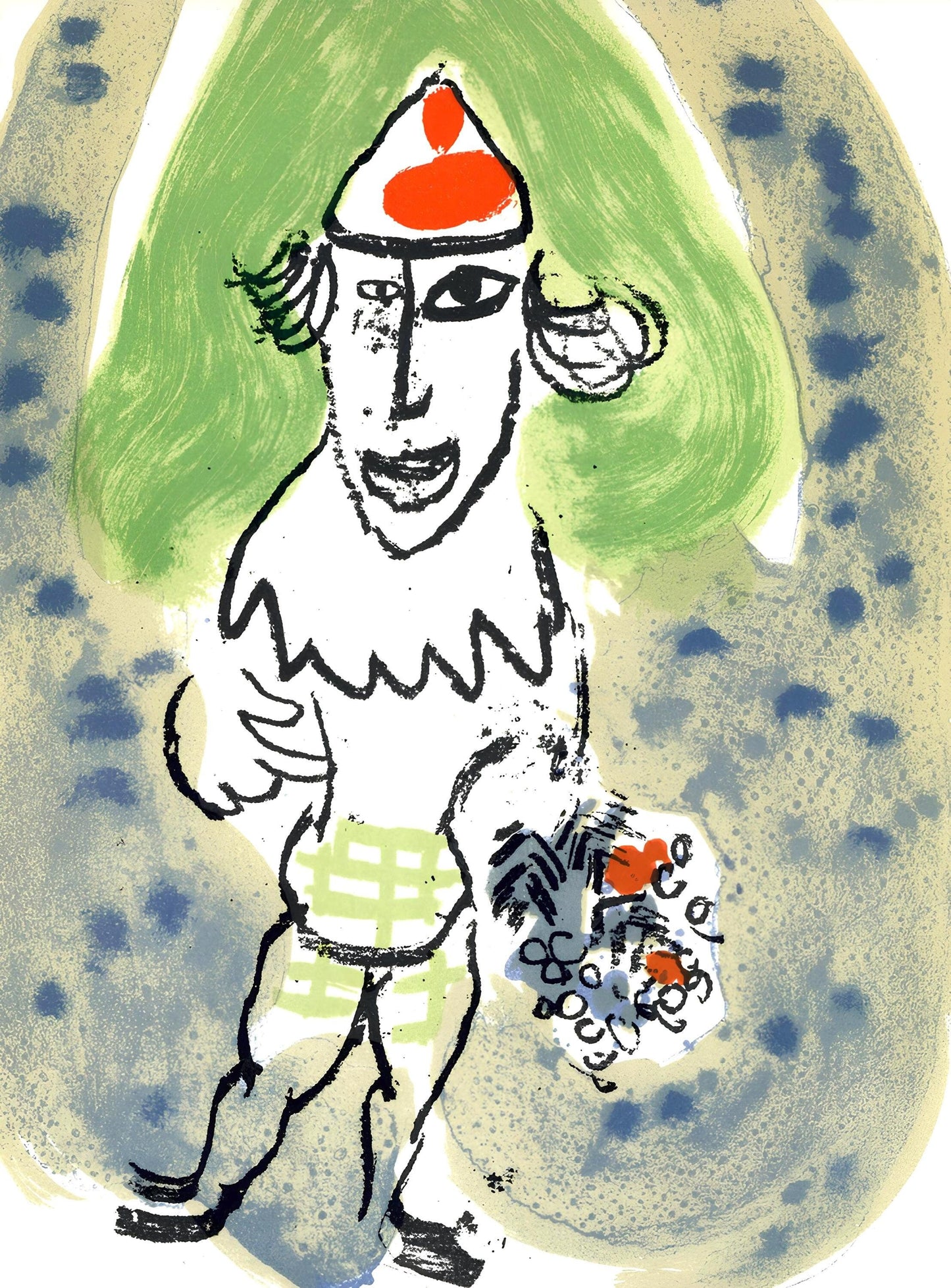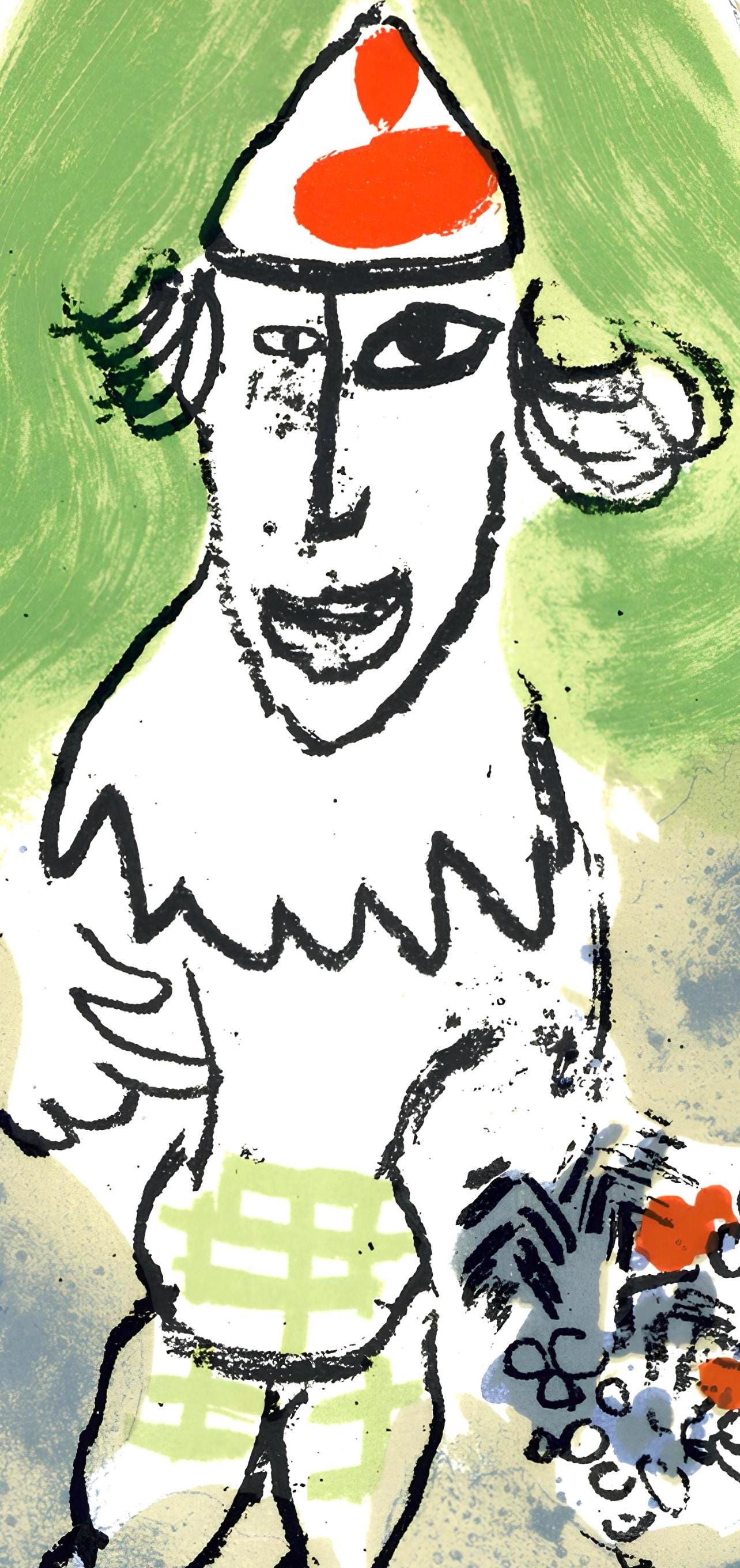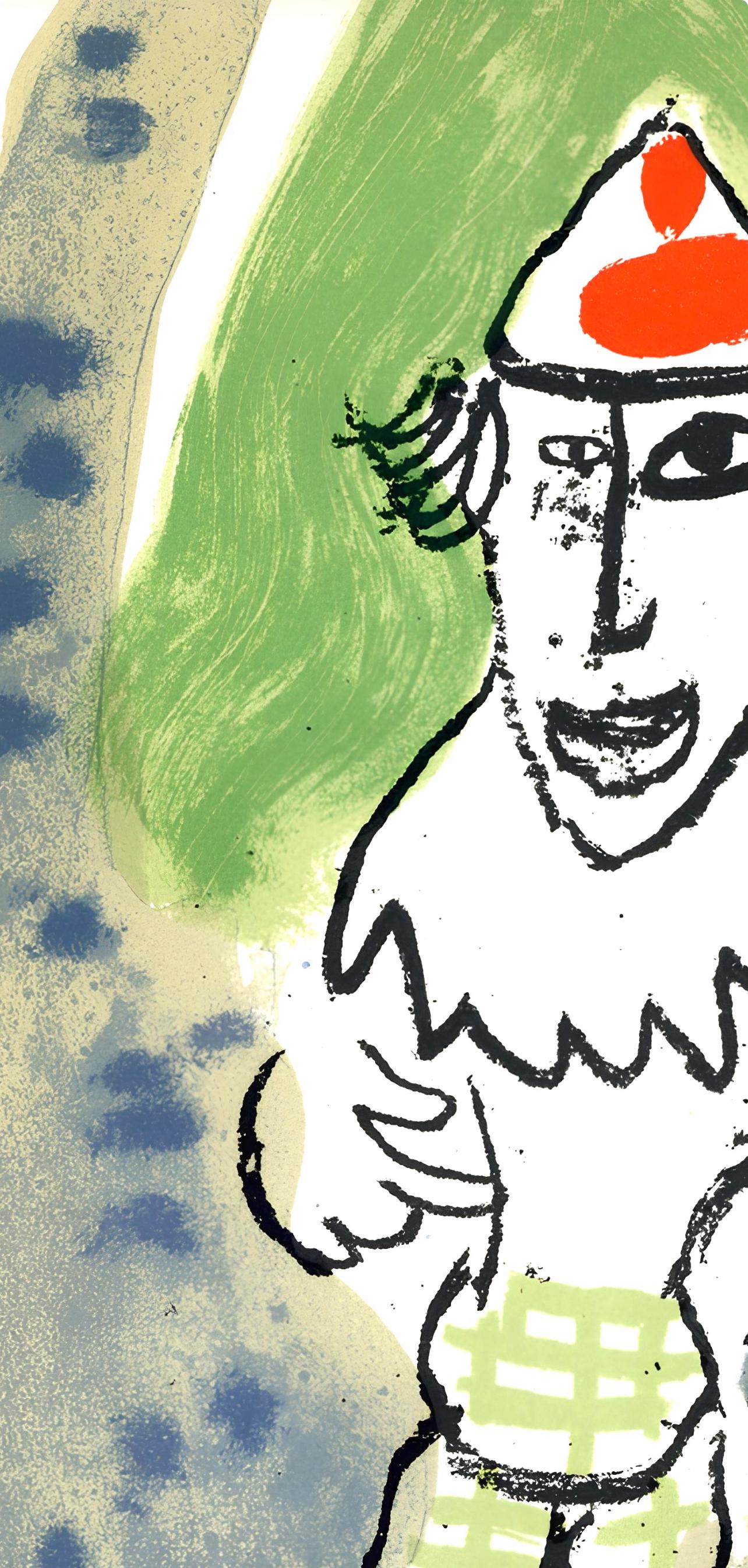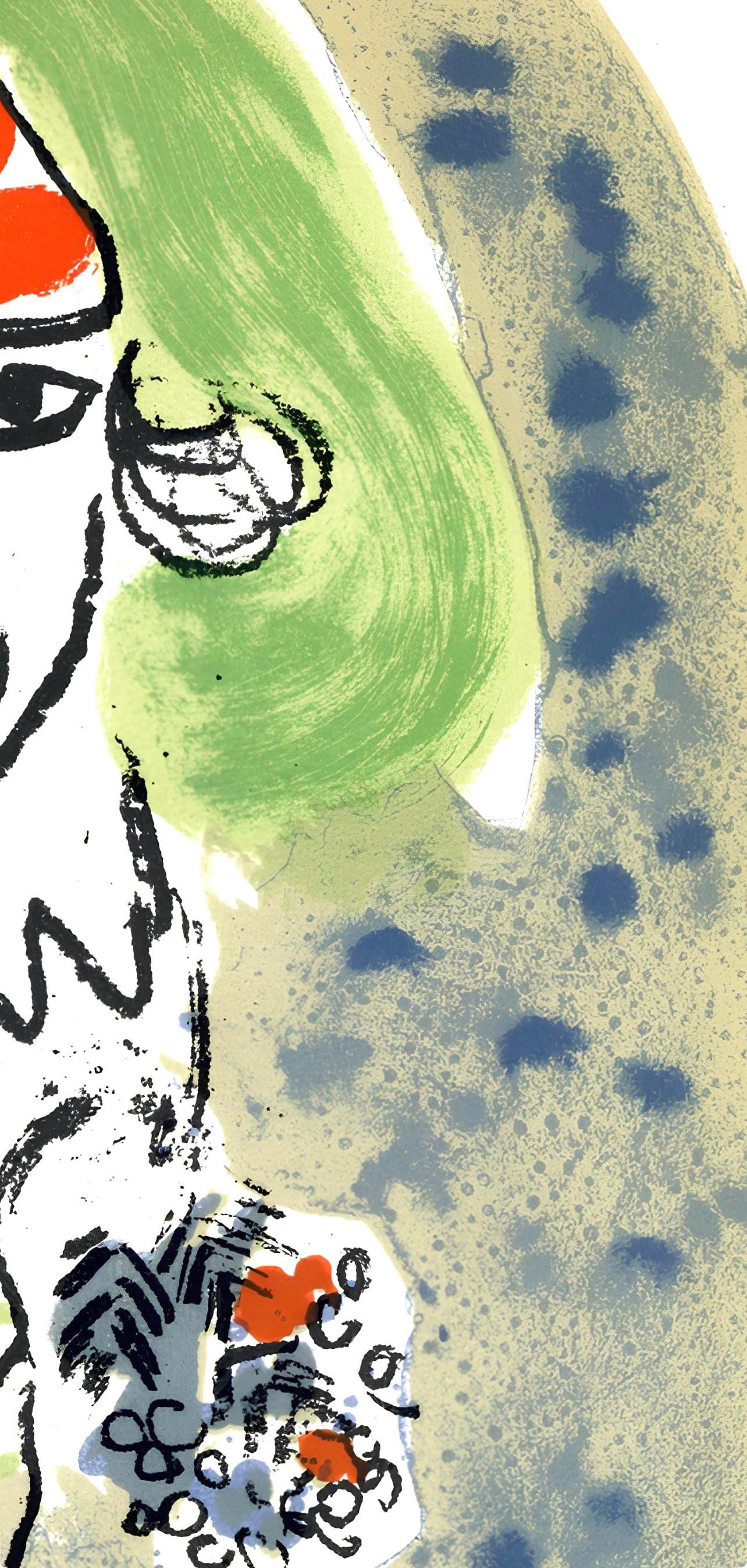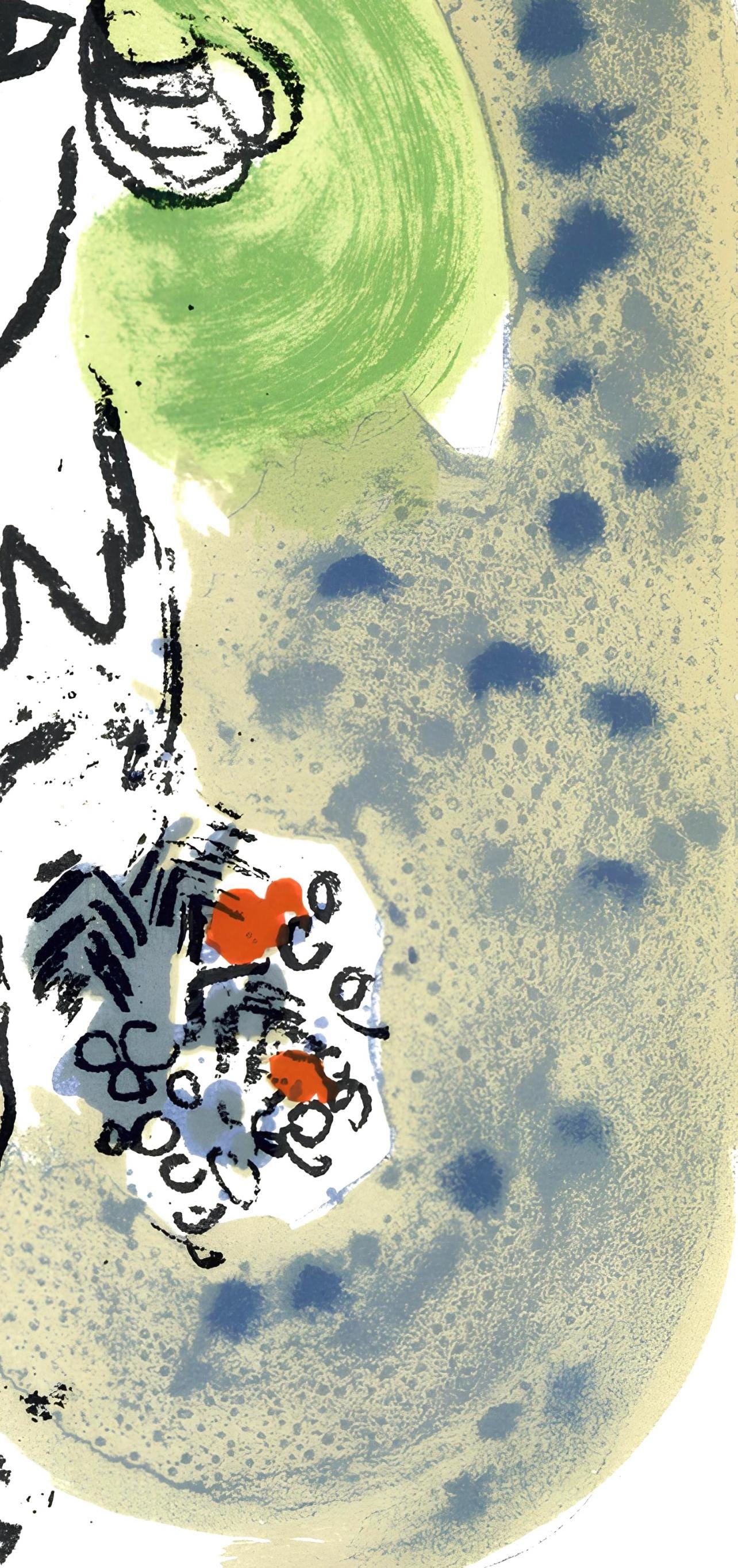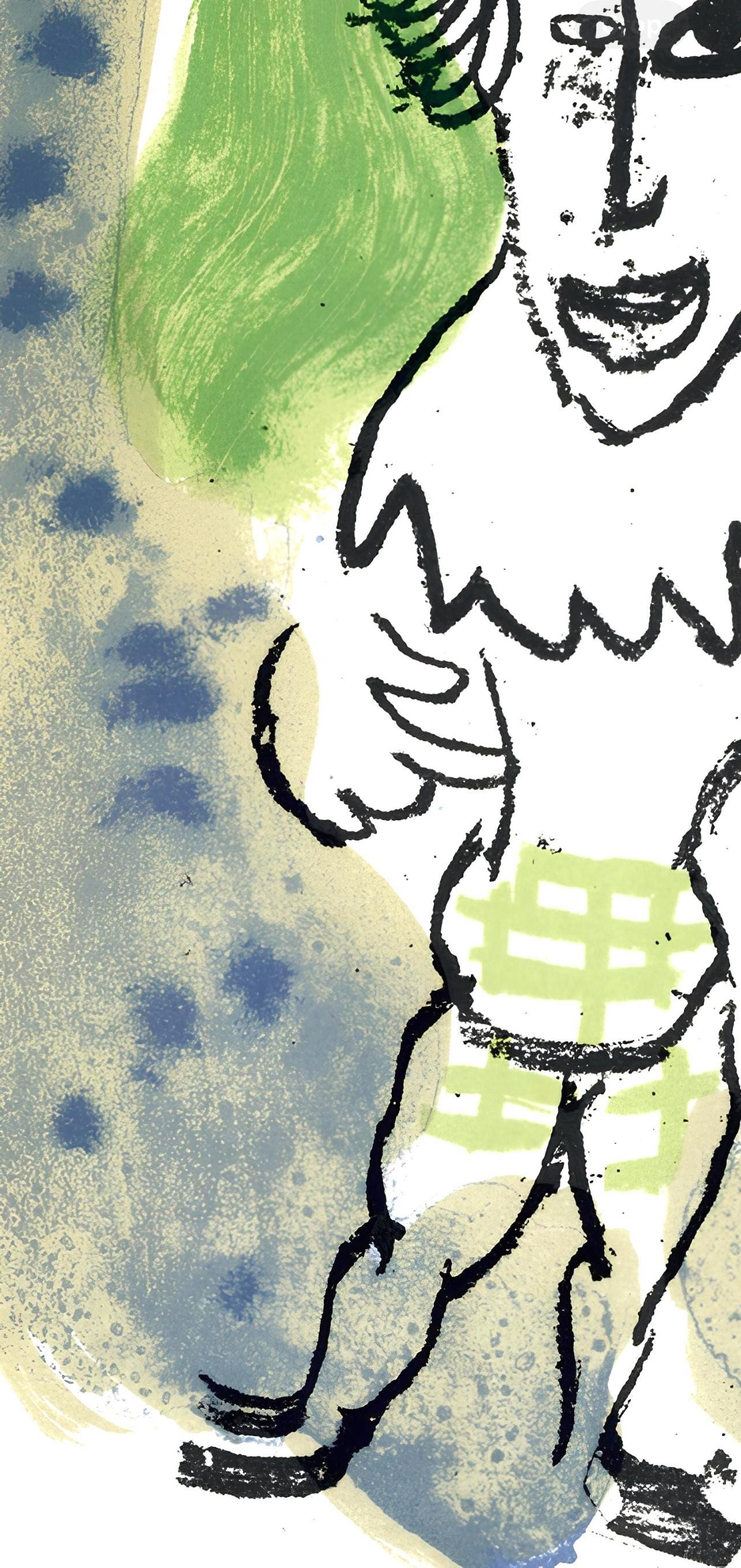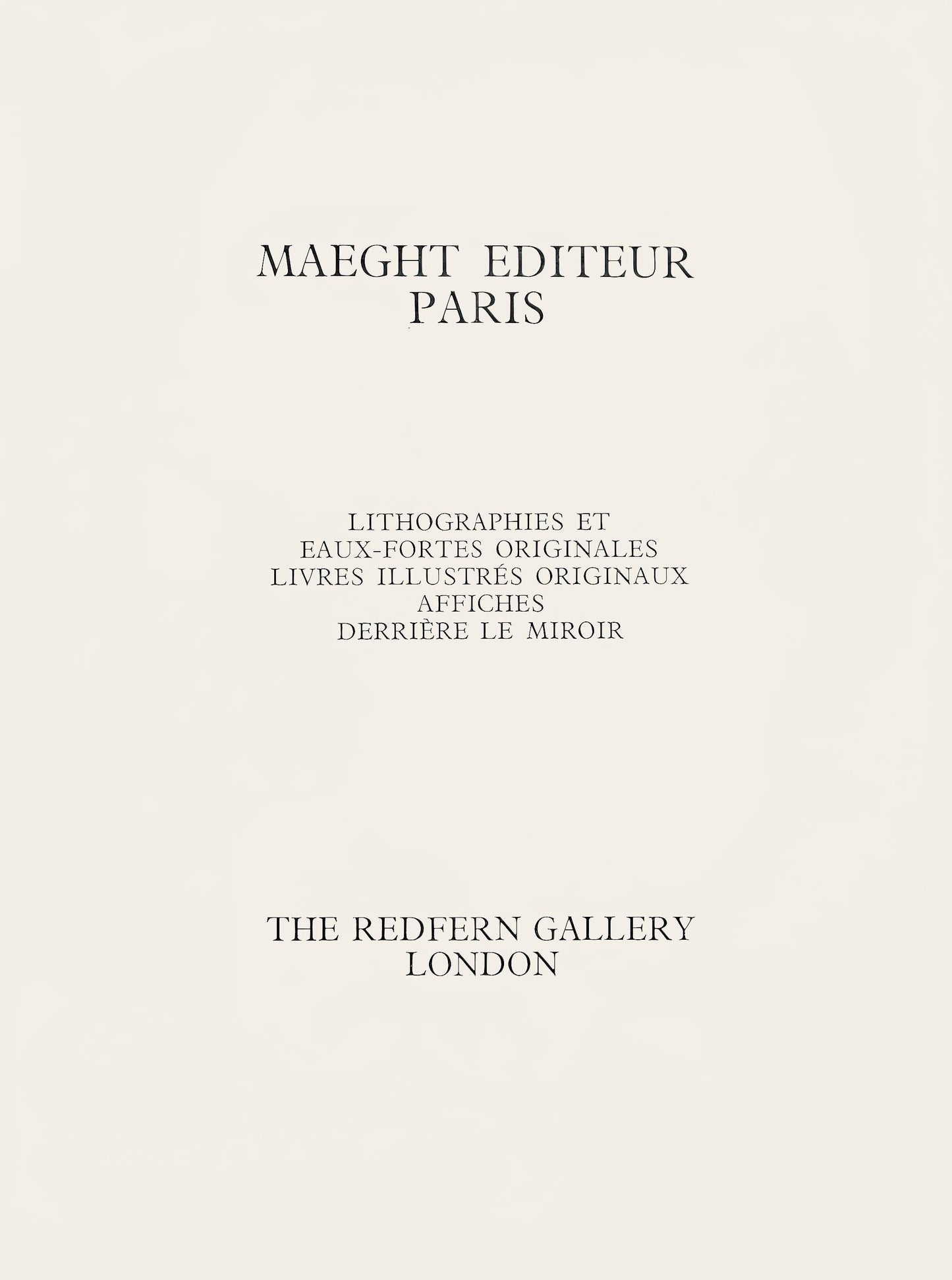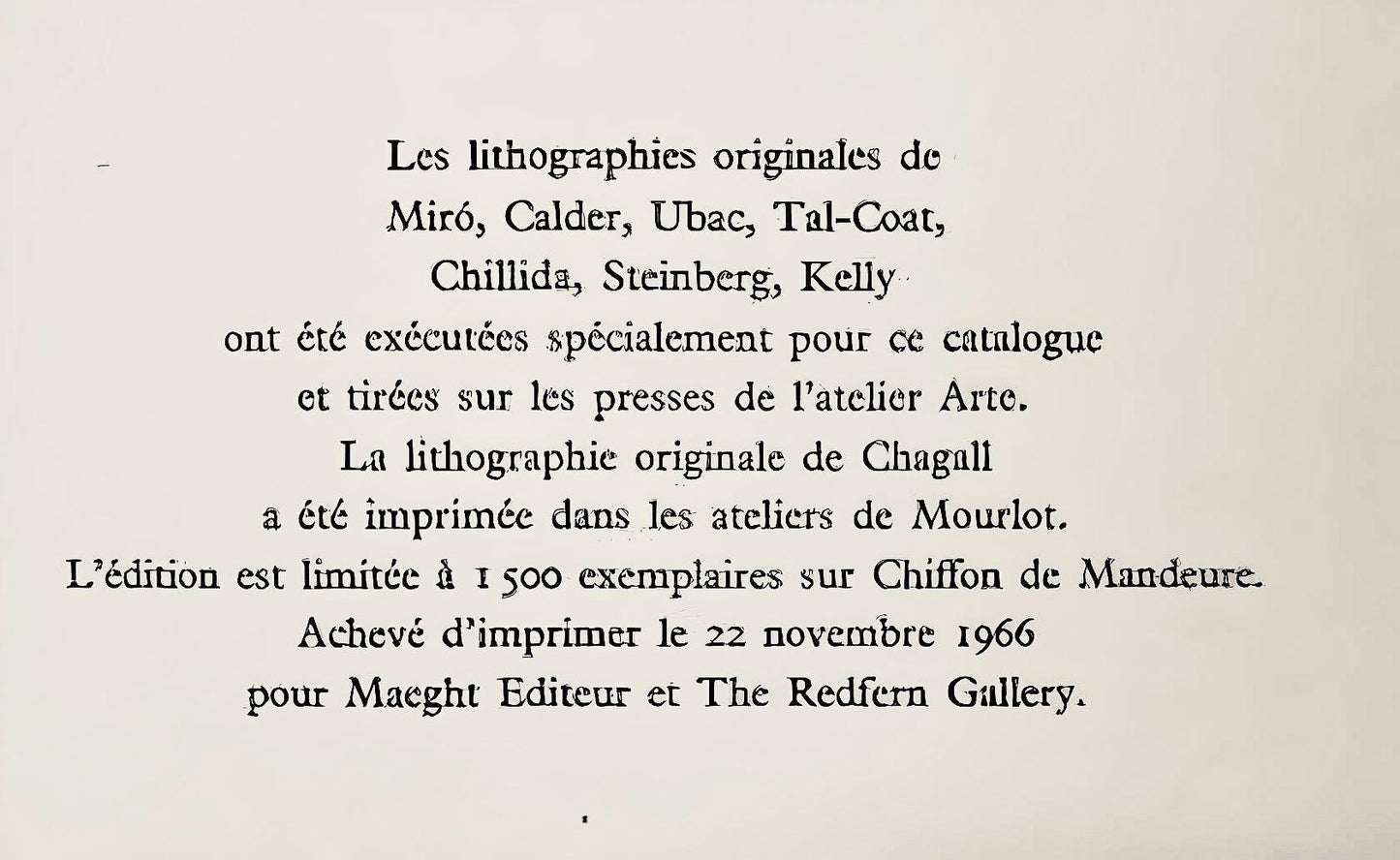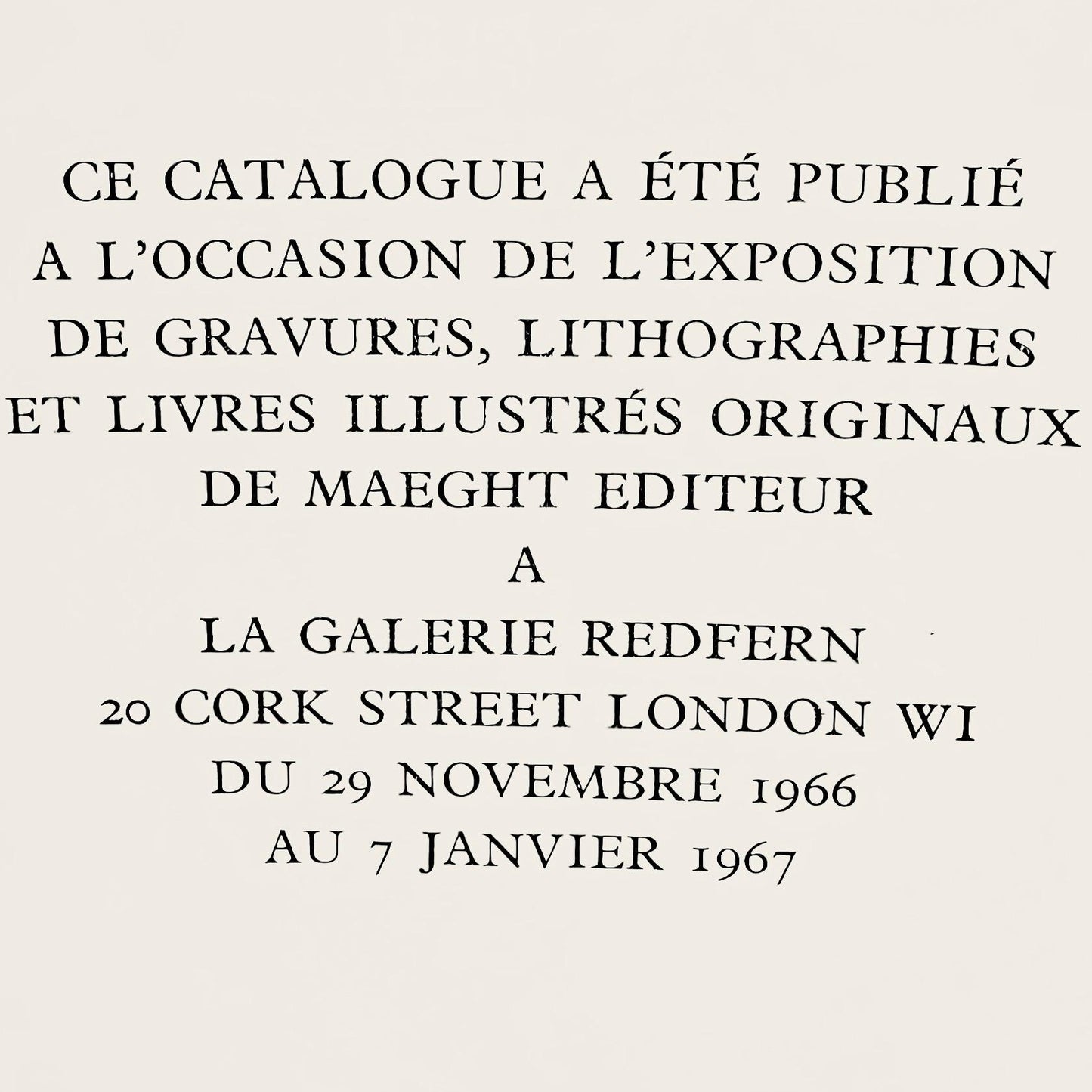1
/
of
9
Auction Ended: July 05, 2025
Post-Auction Sale Ends in:
Marc Chagall, Composition (Mourlot 468), Derrire Le Miroir, Lithograph
Marc Chagall, Composition (Mourlot 468), Derrire Le Miroir, Lithograph
Regular price
$1,012.20 USD
Regular price
$1,506.25 USD
Sale price
$1,012.20 USD
Unit price
/
per
Couldn't load pickup availability
Condition: Pre-Owned
Lithograph on vlin Chiffon de Mandeure paper. Paper size: 10 x 7.475 inches. Excellent condition. Unsigned and unnumbered, as issued. Notes: From the album, Lithographies et Eaux-Fortes Originales, Livres Illustres Originaux Affiches Derrire le miroir, 1966. Published by Maeght diteur, Paris, and Redfern Gallery, London; printed by ditions Pierre Feu, Galerie Maeght, Paris, November 22, 1966. Excerpted from the album (translated from French), The original lithographs ......
Lithograph on vlin Chiffon de Mandeure paper. Paper size: 10 x 7.475 inches. Excellent condition. Unsigned and unnumbered, as issued. Notes: From the album, Lithographies et Eaux-Fortes Originales, Livres Illustres Originaux Affiches Derrire le miroir, 1966. Published by Maeght diteur, Paris, and Redfern Gallery, London; printed by ditions Pierre Feu, Galerie Maeght, Paris, November 22, 1966. Excerpted from the album (translated from French), The original lithographs ......
Condition: Pre-Owned
Lithograph on vlin Chiffon de Mandeure paper. Paper size: 10 x 7.475 inches. Excellent condition. Unsigned and unnumbered, as issued. Notes: From the album, Lithographies et Eaux-Fortes Originales, Livres Illustres Originaux Affiches Derrire le miroir, 1966. Published by Maeght diteur, Paris, and Redfern Gallery, London; printed by ditions Pierre Feu, Galerie Maeght, Paris, November 22, 1966. Excerpted from the album (translated from French), The original lithographs of Mir, Calder, Ubac, Tal-Coat, Chillida, Steinberg, and Kelly were executed especially for this album and printed on the presses of l'atelier Arte. Chagall's original lithograph was printed in l'atelier Mourlot. The edition is limited to MD examples on Chiffon de Mandeure. Finished printing on November 22, 1966 for Maeght diteur and The Redfern Gallery. Excerpted from a Christies, New York lot essay, The life span of Derrire le Miroir was thirty-five years. Publication began in 1946. Aim Maeght, initiator of Derrire le Miroir, had already made few attempts to start publications illustrated with fine printed lithographs in colours in the years prior to the launch of Derrire le Miroir. The name, Derrire le Miroir was suggested by Jacques Kober, manager of Galerie Maeght. The gallery had opened in 1945; the first number of Derrire le Miroir was released a year later. For this first issue Geer van Velde was invited to create lithographs to illustrate the publication. The lithographs in the first issue was printed by Mourlot, Paris. The first three issues of Derrire le Miroir were unsuccessful for Maeght as far as the edition sizethe initial print-runs were far too large. From 30,000 for the first issue, the number was taken down to 10,000 for numbers two and three, until Derrire le Miroir number four was published in an edition of 1500. Maeght instituted a policy whereby unsold issues were recycled and used for the fabrication of new paper for the coming editionsthis served to both conserve resources and also usually result in ultimate edition sizes far less than 1,500. With number four, the permanent format for Derrire le Miroir was established. Lithographs in colours were key; text was limited to comments on the featuring artist's exhibition taking place in the Galerie Maeght, and this catalogue format was defining to Derrire le Miroir. Galerie Maeght took on the leading role in Paris and presented all main artists including Braque, Matisse, Chagall, Lger, Bonnard, Chillida and many more. So too did Derrire le Miroir. The idea of a magazine was meanwhile still on the mind of Aim Maeght. He found an insert as a solution. Two, and later four, pages of art review were inserted from 1952 onwards. In 1968 this find had ripened to independency and the dream of Aim Maeght was now a tangible fact named l'Art vivant. Derrire le Miroir was on it's own again. Over 250 issues in a row. At that point publisher Aim Maeght wished to make a mark with the publication of an hommage to all who once contributed to the magazine which came in the form of issue number 250, but was delayed by the death of Aim Maeght. It was published after number 253 in 1982 and became a tribute to Aim and Margurite Maeght and 35 years of friendship with artists and poets. The era of Derrire le Miroir was closed with that final publication.
MARC CHAGALL (1897-1985) was a Russian-French artist. An early modernist, he was associated with the cole de Paris as well as several major artistic styles and created works in a wide range of artistic formats, including painting, drawings, book illustrations, stained glass, stage sets, ceramics, tapestries and fine art prints. Chagall was born into a Jewish family near Vitebsk, today in Belarus, but at that time in the Pale of Settlement of the Russian Empire. Before World War I, he travelled between Saint Petersburg, Paris, and Berlin. During that period, he created his own mixture and style of modern art, based on his ideas of Eastern European and Jewish folklore. He spent the wartime years in his native Belarus, becoming one of the country's most distinguished artists and a member of the modernist avant-garde, founding the Vitebsk Arts College. He later worked in and near Moscow in difficult conditions during hard times in Russia following the Bolshevik Revolution, before leaving again for Paris in 1923. During World War II, he escaped occupied France to the United States, where he lived in New York City for seven years before returning to France in 1948. Art critic Robert Hughes referred to Chagall as "the quintessential Jewish artist of the twentieth century". According to art historian Michael J. Lewis, Chagall was considered to be "the last survivor of the first generation of European modernists". For decades, he "had also been respected as the world's pre-eminent Jewish artist". Using the medium of stained glass, he produced windows for the cathedrals of Reims and Metz as well as the Fraumnster in Zrich, windows for the UN and the Art Institute of Chicago and the Jerusalem Windows in Israel. He also did large-scale paintings, including part of the ceiling of the Paris Opra. He experienced modernism's "golden age" in Paris, where "he synthesized the art forms of Cubism, Symbolism, and Fauvism, and the influence of Fauvism gave rise to Surrealism". Yet throughout these phases of his style "he remained most emphatically a Jewish artist, whose work was one long dreamy reverie of life in his native village of Vitebsk." "When Matisse dies", Pablo Picasso remarked in the 1950s, "Chagall will be the only painter left who understands what colour really is.
Product Disclaimer: Please review the full description and photos. Lithographs may be plate-signed, hand-signed, or slab-signed and can include a COA (see images); edition numbers shown may vary from the one shipped. Pricing reflects signature type—hand-signed pieces carry a premium and are clearly labeled. 'After' or 'nach' indicates an authorised lithographic reproduction in the style of the named artist, not a unique original. For inquiries, please reach out to support@seuyco.com. By registering for or placing a bid in any SEUYCO auction, you confirm that you have read, understood, and agree to our Shipping, Payment, and Auction Policies.
Lithograph on vlin Chiffon de Mandeure paper. Paper size: 10 x 7.475 inches. Excellent condition. Unsigned and unnumbered, as issued. Notes: From the album, Lithographies et Eaux-Fortes Originales, Livres Illustres Originaux Affiches Derrire le miroir, 1966. Published by Maeght diteur, Paris, and Redfern Gallery, London; printed by ditions Pierre Feu, Galerie Maeght, Paris, November 22, 1966. Excerpted from the album (translated from French), The original lithographs of Mir, Calder, Ubac, Tal-Coat, Chillida, Steinberg, and Kelly were executed especially for this album and printed on the presses of l'atelier Arte. Chagall's original lithograph was printed in l'atelier Mourlot. The edition is limited to MD examples on Chiffon de Mandeure. Finished printing on November 22, 1966 for Maeght diteur and The Redfern Gallery. Excerpted from a Christies, New York lot essay, The life span of Derrire le Miroir was thirty-five years. Publication began in 1946. Aim Maeght, initiator of Derrire le Miroir, had already made few attempts to start publications illustrated with fine printed lithographs in colours in the years prior to the launch of Derrire le Miroir. The name, Derrire le Miroir was suggested by Jacques Kober, manager of Galerie Maeght. The gallery had opened in 1945; the first number of Derrire le Miroir was released a year later. For this first issue Geer van Velde was invited to create lithographs to illustrate the publication. The lithographs in the first issue was printed by Mourlot, Paris. The first three issues of Derrire le Miroir were unsuccessful for Maeght as far as the edition sizethe initial print-runs were far too large. From 30,000 for the first issue, the number was taken down to 10,000 for numbers two and three, until Derrire le Miroir number four was published in an edition of 1500. Maeght instituted a policy whereby unsold issues were recycled and used for the fabrication of new paper for the coming editionsthis served to both conserve resources and also usually result in ultimate edition sizes far less than 1,500. With number four, the permanent format for Derrire le Miroir was established. Lithographs in colours were key; text was limited to comments on the featuring artist's exhibition taking place in the Galerie Maeght, and this catalogue format was defining to Derrire le Miroir. Galerie Maeght took on the leading role in Paris and presented all main artists including Braque, Matisse, Chagall, Lger, Bonnard, Chillida and many more. So too did Derrire le Miroir. The idea of a magazine was meanwhile still on the mind of Aim Maeght. He found an insert as a solution. Two, and later four, pages of art review were inserted from 1952 onwards. In 1968 this find had ripened to independency and the dream of Aim Maeght was now a tangible fact named l'Art vivant. Derrire le Miroir was on it's own again. Over 250 issues in a row. At that point publisher Aim Maeght wished to make a mark with the publication of an hommage to all who once contributed to the magazine which came in the form of issue number 250, but was delayed by the death of Aim Maeght. It was published after number 253 in 1982 and became a tribute to Aim and Margurite Maeght and 35 years of friendship with artists and poets. The era of Derrire le Miroir was closed with that final publication.
MARC CHAGALL (1897-1985) was a Russian-French artist. An early modernist, he was associated with the cole de Paris as well as several major artistic styles and created works in a wide range of artistic formats, including painting, drawings, book illustrations, stained glass, stage sets, ceramics, tapestries and fine art prints. Chagall was born into a Jewish family near Vitebsk, today in Belarus, but at that time in the Pale of Settlement of the Russian Empire. Before World War I, he travelled between Saint Petersburg, Paris, and Berlin. During that period, he created his own mixture and style of modern art, based on his ideas of Eastern European and Jewish folklore. He spent the wartime years in his native Belarus, becoming one of the country's most distinguished artists and a member of the modernist avant-garde, founding the Vitebsk Arts College. He later worked in and near Moscow in difficult conditions during hard times in Russia following the Bolshevik Revolution, before leaving again for Paris in 1923. During World War II, he escaped occupied France to the United States, where he lived in New York City for seven years before returning to France in 1948. Art critic Robert Hughes referred to Chagall as "the quintessential Jewish artist of the twentieth century". According to art historian Michael J. Lewis, Chagall was considered to be "the last survivor of the first generation of European modernists". For decades, he "had also been respected as the world's pre-eminent Jewish artist". Using the medium of stained glass, he produced windows for the cathedrals of Reims and Metz as well as the Fraumnster in Zrich, windows for the UN and the Art Institute of Chicago and the Jerusalem Windows in Israel. He also did large-scale paintings, including part of the ceiling of the Paris Opra. He experienced modernism's "golden age" in Paris, where "he synthesized the art forms of Cubism, Symbolism, and Fauvism, and the influence of Fauvism gave rise to Surrealism". Yet throughout these phases of his style "he remained most emphatically a Jewish artist, whose work was one long dreamy reverie of life in his native village of Vitebsk." "When Matisse dies", Pablo Picasso remarked in the 1950s, "Chagall will be the only painter left who understands what colour really is.
Product Disclaimer: Please review the full description and photos. Lithographs may be plate-signed, hand-signed, or slab-signed and can include a COA (see images); edition numbers shown may vary from the one shipped. Pricing reflects signature type—hand-signed pieces carry a premium and are clearly labeled. 'After' or 'nach' indicates an authorised lithographic reproduction in the style of the named artist, not a unique original. For inquiries, please reach out to support@seuyco.com. By registering for or placing a bid in any SEUYCO auction, you confirm that you have read, understood, and agree to our Shipping, Payment, and Auction Policies.
+ Read More
